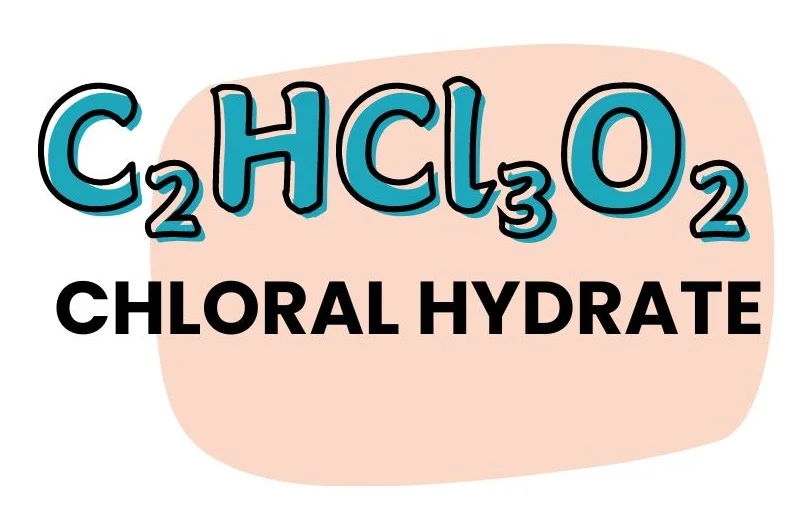Chloral hydrate is a sedative and hypnotic agent that has been used since the late 19th century.
Initially developed for its sedative effects, it is now primarily used in homeopathic medicine.
Despite its potent hypnotic properties, chloral hydrate also exhibits significant side effects, particularly on the skin and the cardiovascular system.

SOURCE INFORMATION
Scientific Classification
- Common Name: Chloral Hydrate
- Chemical Formula: C₂HCl₃O₂
- CAS Number: 302-17-0
- Molecular Weight: 165.45 g/mol
Origin and Historical Facts
- First synthesized in 1832 by Friedrich Wöhler, chloral hydrate gained popularity as a sedative in the mid-1800s.
- It was used in treating various conditions, including insomnia, anxiety, and as a pre-anesthetic agent before surgeries.
- Its use has declined due to the emergence of newer sedatives with fewer side effects.
DRUG PATHOGENESIS
- Chloral hydrate acts as a powerful central nervous system depressant, primarily affecting the cerebral cortex.
- Its sedative effects are mediated through the enhancement of the inhibitory neurotransmitter gamma-aminobutyric acid (GABA), leading to decreased neuronal excitability.
- However, its depressant effects can also result in complications such as respiratory depression and cardiac dysregulation.
PHYSICAL CONSTITUTION
- Chloral hydrate is typically presented in crystalline form, soluble in water and alcohol.
- It is used both internally (in higher potencies) and externally (as a dilute solution) in homeopathic practice.
DIATHESIS
- Those with heightened emotional excitability, anxiety, and sensitivity to sensory stimuli.
TEMPERAMENT
- Individuals who are easily agitated or suffer from night terrors, particularly in children.
KEY CHARACTERISTICS
- Sedative and hypnotic effects
- Cardiac depressant properties
- Marked impact on skin (erythema, urticaria)
DETAILED ORGAN SYMPTOMS
HEAD
- Morning headaches, worse in the forehead and occiput.
- Passive cerebral hyperaemia, feeling as if a hot band is drawn across the head.
- Auditory hallucinations, such as hearing voices.
EYES
- Bloodshot and watery eyes, with circles of light and black spots.
- Illusions of sight, especially in dim light or with closed eyes.
- Symptoms of conjunctivitis and burning sensations in the eyes.
SKIN
- Red blotches resembling measles; urticaria that worsens with hot drinks or alcohol.
- Intense itching and erythema exacerbated by cold, improving with warmth.
- Conditions like purpura, with cold skin surfaces.
RESPIRATORY
- Severe dyspnea with a feeling of constriction in the chest.
- Asthmatic symptoms associated with insomnia.
SLEEP
- Insomnia accompanied by hallucinations and terrifying dreams.
- Somnolence or excessive sleepiness during the day.
MODALITIES
- Worse: After consuming hot drinks, stimulants, eating, and during the night.
- Better: Symptoms may improve with warmth and rest.
RELATIONSHIP WITH OTHER DRUGS
Antidotes: Ammonium, Atropine, Digitalis, Musk.
Comparisons
- Belladonna: For hyperexcitable states.
- Opium: Used for its sedative properties in severe pain or anxiety.
- Apis Mellifica: For conditions with swelling and allergic reactions.
- Luminal: For sleep disturbances associated with skin symptoms.
DOSE
- General: First trituration for hives; otherwise, use higher potencies based on symptoms.
- Local Application: One percent solution for offensive foot sweat.
- Physiological Effects: Typically, 5 to 20 grains, administered cautiously due to potential side effects.
Frequently Asked Questions
What is chloral hydrate used for?
- Chloral hydrate is primarily used as a sedative and hypnotic agent in homeopathic medicine, especially for insomnia and anxiety.
How is chloral hydrate administered?
- It can be taken orally in higher potencies or applied topically in a diluted solution.
Is chloral hydrate safe for children?
- It can be used cautiously in children, particularly for night terrors, but should be administered under professional guidance due to potential side effects.
Glossary of Difficult Words
- Erythema: Redness of the skin caused by increased blood flow.
- Ecchymosis: A discoloration of the skin resulting from bleeding underneath, commonly known as a bruise.
- Hallucinations: Sensory experiences that appear real but are created by the mind, often related to mental health disorders.
- Somnolence: Excessive sleepiness or drowsiness.
- Dyspnea: Difficult or laboured breathing.
- Urticaria: A rash characterized by red, itchy welts on the skin, commonly known as hives.
This detailed overview provides a comprehensive understanding of chloral hydrate as a homeopathic remedy, its effects, and considerations for use.
If you have further questions or need additional information, feel free to ask!
